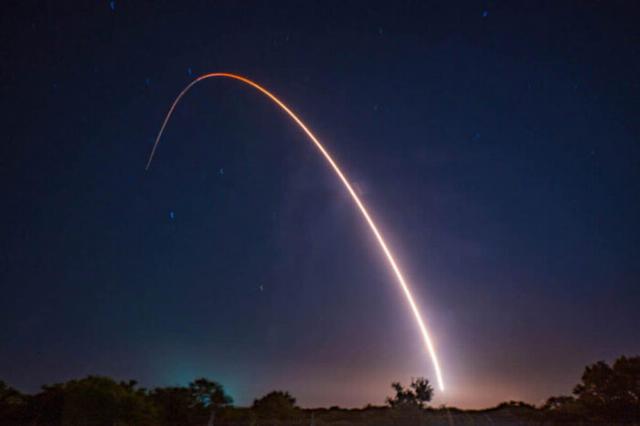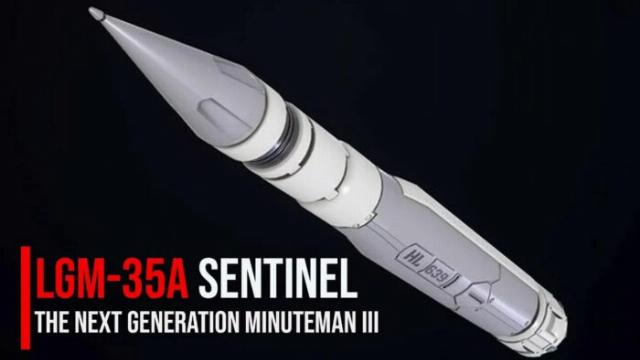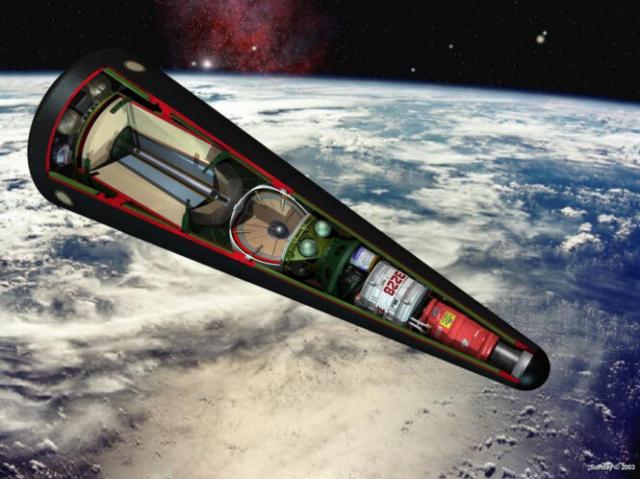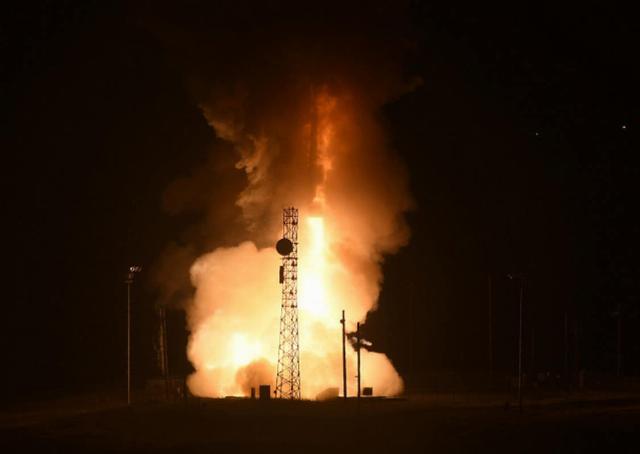Moving from the tactical to the strategic level, we note that the United States continues its efforts to maintain the 50-year-old intercontinental ballistic missile (ICBM) "Minuteman" (LGM-30 Minuteman III). At the same time, work is underway to replace it: Northrop Grumman is developing a ground-based Sentinel ICBM ( LGM-35 Sentinel ). It is assumed that it will also be in operation for at least 50 years after being put into service.
At the same time, it is considered necessary to preserve the capabilities of the Minuteman in order to ensure a complete and unhindered transition from one nuclear deterrent system to another.
Currently, about 400 Minuteman III missiles are on alert, each equipped with one special warhead W78 (335 kT) or W87 (300 kT) and located in one of about 450 mines scattered over thousands of square kilometers in several states. This is a marked reduction compared to the approximately 1,000 Minuteman I, II, and III missiles deployed in the 1970s.
Since the New START Treaty expires in 2026, the United States plans to deploy the Minuteman III ICBM with three warheads again. To this end, on November 5, 2024, a test launch of a Minuteman III ballistic missile with three warheads was conducted from Vandenberg Air Force Base (AvB) (California).

The Minuteman III ballistic missile test in May 2025
The last time the Minuteman III demonstrated its combat readiness was on May 21, 2025, when the United States Air Force Global Strike Command (AFGSC) conducted a planned test launch from the Vandenberg Air Force Base of an unarmed Mk-21 single-stage return vehicle (VVA) with increased accuracy. These missiles are designed to deliver the W87 warhead. AvB Vandenberg is the main testing ground for the entire AFGSC nuclear deterrent ecosystem.
According to AFGSC, the Minuteman III ICBM flew about 7,780 km west across the Pacific Ocean to the missile defense system test site. Ronald Reagan at Kwajalein Atoll in the Marshall Islands. The test site, which is part of the U.S. Army Aerospace Defense Command, is equipped with various sensors, including high-precision radar and optical systems that collect telemetry data during the final stage of rocket flight. Analyzing this data helps determine the overall effectiveness of the system. The test launch was conducted by the 337th AvB Vandenberg Test and Evaluation Group, responsible for testing and evaluating U.S. intercontinental ballistic missiles. The same unit will perform similar functions under the Sentinel program.
The Sentinel ballistic missile is a costly project
One of the most interesting aspects of the latest LGM-35A Sentinel program was the decision to redirect excess funds from the program's budget for 2024 to a project to convert the Boeing 747, donated by Qatar to the Trump administration, into an interim version of the presidential aircraft No.1. Secretary of the Air Force Troy Maink confirmed that the Sentinel program is fully funded, despite the redirection of funds, which was made possible only by restructuring the program and a complete review of cost overruns.

The Sentinel ballistic missile
Indeed, one of the unforeseen additional infrastructure expenses was related to the construction of silo launchers. If in previous estimates the program was calculated based on the assumption that 450 existing Minuteman III silos would simply be repaired and reused for Sentinel, then in the end it became clear that completely new mines would have to be built to accommodate them, which would entail significant additional costs. While the program was initially expected to cost $77.7 billion, it eventually reached $160 billion. According to the Pentagon, by the time Sentinel is commissioned, it will cost almost 141 billion dollars. Moreover, each rocket will cost 162 million US dollars.
At about the same time that all this was happening, the United States Air Force Nuclear Weapons Center (AFNWC), together with Northrop Grumman, the general contractor of the Sentinel program, and Aerojet subcontractor Rocketdyne, conducted firing tests of the LGM-35A Sentinel solid-fuel rocket engine (turbofan engine) of the third stage of the LGM-35A Sentinel ICBM at the AVB Arnold Engineering Development complex on March 16, 2024. in Tennessee. This was the third such test of the Sentinel three-stage propulsion system.
Preparation of the Sentinel turbofan engine for testing
In accordance with the terms of the Northrop Grumman contract for design, production and development for Sentinel, a successful test of the second-stage turbofan engine was completed in January 2024 at the same location, in a vacuum chamber to simulate the environmental conditions that the engine will encounter during high-altitude and space flight. The company develops and manufactures the first and second stages of the Sentinel three-stage ballistic missile.
After the successful completion of the tests in early 2024, the company, together with the US Air Force, began qualification tests, and the data obtained during the turbofan engine tests are used for ongoing modeling and design. Earlier, under the same contract, fire tests of the first-stage turbofan engine and tests in a hypersonic wind tunnel were conducted.
The US Air Force plans to purchase about 634 Sentinel ICBMs, and another 25 will be purchased for conducting training test launches with inert warheads. 400 ballistic missiles will be deployed in the new silos in a state of operational readiness. The remaining 234 are supposed to be stored in warehouses. The program also provides for the modernization of 450 bunkers and 600 facilities as part of a broader ecosystem of command and control centers, monitoring and administration facilities located on an area of about 100,000 square kilometers in the states of California, Colorado, Nebraska, North Dakota, Montana and Wyoming.
The combat unit of the future
While the Minuteman III ICBMs, as mentioned earlier, are equipped with a W87 warhead, the W87-1 modification program is underway to revitalize and transform the American nuclear warhead production facility, which declined after the end of the Cold War, as well as create a new warhead that will eventually be equipped with Sentinel ICBMs.".
Thanks to this program, Nuclear Security Enterprise (NSE) The United States will once again become a turnkey manufacturer of all the components needed to create a modern nuclear warhead. In fact, the W87-1 will be the first completely new nuclear warhead to enter service with the US Armed Forces after the end of the Cold War.

W88 Nuclear Warhead
On the way to achieving this goal, the National Nuclear Safety Administration (NNSA) of the U.S. Department of Energy announced an important milestone in October 2024.: It completed the construction and stamped the first manufactured plutonium core unit (FPU) for the new W87-1 warhead. Plutonium cores are a necessary component of every American nuclear warhead, and the U.S. Nuclear Resources Management Agency is currently restoring the country's capacity to produce at least 80 cores per year. During the Cold War, hundreds of cores were produced per year, but production stopped after the fall of the Berlin Wall in 1989 and the end of the Cold War.
The NNSA stated that "achieving the FPU for the W87-1 core is an important milestone in modernizing the US nuclear weapons stockpile," especially given that the new warhead supports the Sentinel ICBM program. Stamping means that the FPU core meets all the requirements for inclusion in the US nuclear stockpile as a "military reserve". To achieve this goal, scientists from Lawrence Livermore National Laboratory, Los Alamos National Laboratory (LANL), the National Security Campus in Kansas City (KCNSC) and the National Security Complex in Nevada collaborated with NNSA for eight years. Livermore Laboratory was responsible for the design of the core, and its manufacture was completed at LANL.
According to the NNSA, the continuous production of plutonium cores is vital for nuclear stocks. The target capacity of 30 cores per year at LANL is the current target, albeit by an unspecified date, with equipment installation and other facility improvements still required to ensure "increasingly reliable production facilities." Meanwhile, a plutonium reprocessing plant is under construction at the Savannah River site in South Carolina. According to NNSA, it is planned to achieve a capacity of 50 cores per year "in the mid-2030s" as part of the nuclear weapons production complex.
It is still unclear whether this production rate is in line with the planned commissioning dates and requirements of Sentinel, as the new ICBM is expected to begin replacing the Minuteman III in 2029, with its commissioning scheduled for 2030.
Source: euro-sd.com

